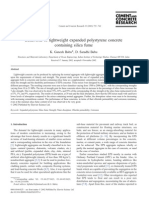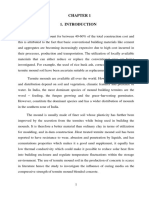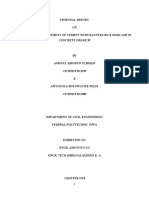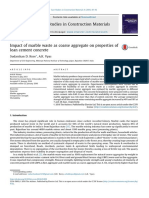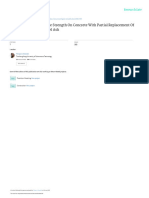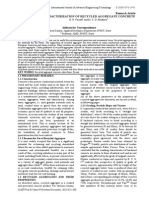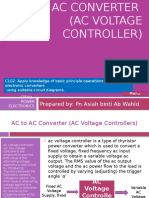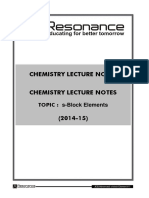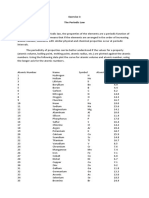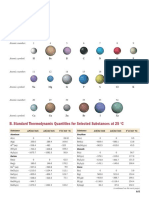Study of Compressive Strengths of Laterite-Cement Mixes As A Building Material
Study of Compressive Strengths of Laterite-Cement Mixes As A Building Material
Uploaded by
Arjun KumarCopyright:
Available Formats
Study of Compressive Strengths of Laterite-Cement Mixes As A Building Material
Study of Compressive Strengths of Laterite-Cement Mixes As A Building Material
Uploaded by
Arjun KumarOriginal Description:
Original Title
Copyright
Available Formats
Share this document
Did you find this document useful?
Is this content inappropriate?
Copyright:
Available Formats
Study of Compressive Strengths of Laterite-Cement Mixes As A Building Material
Study of Compressive Strengths of Laterite-Cement Mixes As A Building Material
Uploaded by
Arjun KumarCopyright:
Available Formats
AU J.T. 13(2) 114-120 (Oct.
2009)
Study of Compressive Strengths of Laterite-Cement Mixes
as a Building Material
James Isiwu Aguwa
Civil Engineering Department, Federal University of Technology
Minna, Nigeria
E-mail: <jiaguwa@yahoo.com>
Abstract
Variation of compressive strengths with cement contents for laterite-cement mix
as an economical building material was investigated. The aim of this study was to
determine the minimum quantity of cement required to achieve adequate strength for
buildings in a mix of laterite-cement and to know the upper limit at which cement can be
added to laterite to produce high quality mix with maximum strength. Thirteen different
mixes of laterite-cement at varying percentage of cement content were produced,
molded in cubes of 100mm size and cured for 7, 14, 21 and 28 days. The variation was
from 0 to 24% of the weight of laterite at a constant interval of 2%. Twenty cubes were
molded for each mix, totaling 260 cubes produced manually. Five cubes from each mix
were crushed at particular curing period and the average compressive strength of the
five cubes was calculated. Curing was done inside the laboratory under atmospheric
condition with all the doors and windows opened for proper circulation of air. It was
found that the compressive strength of laterite-cement mix cubes increased with
increase in cement content up to 20% but decreased at cement contents above 20%.
Also it was found that the minimum quantity of cement required to achieve adequate
strength was 10% of the weight of laterite.
Keywords: Curing, Building, Cubes, sandcrete blocks.
together cement and sand in certain proportion
with water produces these sandcrete blocks
(NIS 87: 2004). Now cement price has been on
the steady increase at an alarming rate. Also
the price of river sharp sand used in the
production is ever increasing due to shortage of
it and cost of water used for mixing is high due
to demand for production and curing. As a
result of this ever-increasing cost of these
constituent production materials, coupled with
the increasing high demand, the price of
sandcrete
blocks
has
correspondingly
increased. Greater percentage of the countrys
population finds it difficult or almost
impossible to afford the cost.
The aim of this study is to determine the
minimum and maximum quantity of cement in
terms of the percentage of the quantity of
laterite at which adequate compressive strength
can be achieved for both non-load bearing and
load bearing walls. It is known that addition of
cement to laterite improves the quality in terms
Introduction
Traditionally, soils with some percentage
of silt and clay have been used for building
non-load bearing walls. Such buildings still
exist in villages and some ancient cities today.
They exhibit a lot of cracks within a short time
due to lack of binding materials such as cement
and some times due to considerable amount of
shrinkage. Also the use of the mud blocks is
generally limited to bungalows.
In Nigeria today, an appreciable
percentage of the entire population cannot
afford to build their own houses, especially the
modern types due to high cost of building
materials.
Sandcrete
blocks
constitute
important building materials widely used today
for walls of our domestic, industrial or
commercial buildings. The cost of sandcrete
blocks continues to increase due to high cost of
cement and demand for this material. Mixing
Technical Report
114
AU J.T. 13(2) 114-120 (Oct. 2009)
be dusted off when dry. Also some laboratory
index property tests are used to classify laterite.
Such tests are the Atterberg limit, grain size
distribution, compaction, specific gravity and
linear shrinkage (Madu 1975). The results of
these tests are used to compare with the already
determined standard index properties for
laterite. Laterite is generally used as foundation material and in road construction as base
material.
of strength but the proper mix ratio has not
been well established. The first step in this
study was to establish that the sample used was
laterite. This was done by carrying out
Atterberg limits test, to establish the plastic
limit, liquid limit, plasticity index and the grain
size distribution test. These results were
compared with already determined standard
properties for laterite. Laterite exists in most
parts of this country and a good proportioned
mix of laterite and cement may prove to be
quite suitable for buildings. Often one of the
problems encountered in the study of laterite is
the basic definition of what is laterite. Many
people usually define laterite as a type of red
soil used in road construction especially in the
tropics. Although laterite physically has
element of red color, the above definition is not
a clear and true one in that some soils such as
red sandy-clay soil can easily be mistaken as
laterite (Madu 1984). Laterite may be defined
as that class of pedogenics in which the
cementing materials are the sesquioxides and
constitute not less than 50% of its constituents
when the sample is chemically analyzed (Madu
1977). Sesquioxides are those chemical
substances with empirical formula M2O3 where
M = potassium (K), rubidium (Rb) or cesium
(Cs). At ordinary temperatures and pressure
below 100mm mercury, potassium peroxide
combines with oxygen to give the
sesquioxides, K2O3. Study of laterite shows
that it contains hydrated aluminum and iron
oxides. The presence of iron can be noticed by
the characteristic color produced by iron in the
soils. The aluminum is generally in the form
Al2O3.nH2O, which is called bauxite, an ore of
aluminum. The ore appears to be developed
when intense and prolonged weathering
removes the silicon from the clay minerals and
leaves a residue of hydrous aluminum oxide
(Gidigasu 1971).
Before carrying out chemical analysis for
complete definition of laterite, a soil may be
suspected to be laterite by observing some of
the physical properties. Usually, laterite is
reddish brown in color and gravelly in texture.
The reddish color becomes predominant when
wet while the brown color becomes distinct
when dry. Some of the particles stick to the
palm of the hand when wet and they can easily
Technical Report
Materials Used and Methods of Testing
Soil
The laterite sample used was collected at
a depth of 1.5 to 2.5m from an existing borrow
pit behind Nigerian Television Authority
station at Independence layout Enugu, using
method of disturbed sampling. An investigation
into the geotechnical and engineering
properties of some laterite of Eastern Nigeria
by Madu (1977) showed that the sample
collected was laterite and the index properties
are summarized in Table 1.
Cement
The cement used was ordinary Portland
cement (NIS 444, 2003) bought from cement
depot at Enugu, Nigeria.
Water
Clean tap water free from contaminants
either dissolved or in suspension (BS 3148,
1980) was used to prepare the specimen cubes
at various moisture contents.
Laboratory Tests
All laboratory tests carried out which
included determination of natural moisture
content of the laterite, particle size distribution
of laterite, liquid limit for the laterite, plastic
limit for the laterite, linear shrinkage of the
laterite, specific gravity of the laterite, dry
density/moisture content relationship for
laterite and laterite-cement mix were in
accordance with (BS 1377 1975).
115
AU J.T. 13(2) 114-120 (Oct. 2009)
gone very far (Madu 1984). This is because test
results are affected by partial hydration of
cement which can cause an increase in the
optimum moisture content and a decrease in
the maximum dry density. For this reason, once
a laterite-cement mix was compacted in the
mold, it was thrown away and a new mix was
taken for the next compaction.
Mix Proportioning
The term proportioning in this content
refers to the estimation of different quantities
of laterite and cement as well as water required
for the mix. The following calculations were
carried out for the proportioning:
Water/cement ratio adopted was 0.5;
Size of laterite-cement cube for the test was
100mm x 100mm x 100mm;
Volume of laterite-cement cube=0.1x0.1x0.1=
0.001m3;
For cement content of 10% of dry weight
of laterite, the mix ratio was 1: 10,
Laterite, L = 10C .
(1)
Also from the water/cement ratio of 0.5,
Water, W = 0.5C.
(2)
Using Absolute Volume Method,
W/1000 + C/1000Gc + S/1000Gl =1m3, (3)
where L is weight of laterite, C is weight of
cement, Gl is the specific gravity of laterite and
Gc is the specific gravity of cement.
Determined Gl was 2.64 and Gc was 3.15.
By substitution of Eqs. (1) and (2) into
Eq. (3):
0.5C/1000+C/1000 x 3.15+10C/1000 x 2.64 = 1,
C = 217.16kg;
From Eq. (1), L = 10 x 217.16 = 2171.6kg;
From Eq. (2), W = 0.5 x 217.16 = 108.58kg;
Volume of one laterite-cement cube = 0.001m3;
For 20 cubes, volume = 20 x 0.001= 0.02m3;
1m3 of the mix contained 217.16kg of cement;
0.02m3 = 0.02 x 217.16 = 4.343kg of cement;
Add for waste, 1% = 0.01 x 217.16 = 2.172kg;
Total weight of cement required = 6.515kg;
Weight of water =0.5C = 0.5 x 6.515 = 3.258kg;
Weight of laterite, L =10C=10x6.515=65.15kg.
Quantities of the materials used to mold
20 laterite-cement cubes of 100mm x 100mm x
100mm were:
Cement = 6.52kg;
Laterite = 65.15kg;
Water = 3.26kg.
The above calculations were repeated for
each of the thirteen mixes.
Determination of dry density/moisture
content relationship was carried out on each of
the thirteen mixes in accordance with BS 1377
(1975) The compaction test was done as
rapidly as possible after mixing the cement and
water and before the hydration of cement has
Technical Report
Mixing and Molding
The quantities as calculated above were
measured, mixed and molded for each mix
ratio. First the laterite and cement were
properly mixed manually before the addition of
water. For the purpose of this research, small
size cube molds of 100mm by 100mm by
100mm were used. Sufficient quantity of
laterite-cement mix prepared as described was
placed in the mold to fill it approximately onethird when compacted. To ensure even
distribution of blows, approximately 100mm
square sheet of plywood was placed on the
mixture in the mold and compaction was done
on it using 28 blows of a standard rammer of
weight 2.5kg which, was falling from effective
height of 30cm (BS 1377 1975). Then the mold
was filled with two additional layers of lateritecement and the same 28 blows were given to
each layer. A wooden collar which was
removed after compaction was used for the last
layer to ensure that the mold was full of
compacted laterite. The surface of the
compacted mixture was trimmed off level with
the top of the mold with a straight edge. A total
of two hundred and sixty cubes were molded
for the tests.
After the compaction of first and second
layers, the smooth surfaces were scarified with
a spatula to ensure proper bonding or cohesion
with the next layer (Aderibigbe et al. 1984).
There was the tendency for the laterite-cement
mixture to stick to the sides of the mold and
cause tearing during extrusion. This problem
was taken care of by properly oiling the inside
surfaces of the molds before each casting
(Aderibigbe et al. 1984). It was also ensured
that the molds were filled in three equal layers.
116
AU J.T. 13(2) 114-120 (Oct. 2009)
increased steadily with increase in cement
content up to 14% and decreased continuously
for cement contents above 14%. The maximum
dry densities for the various mixes of lateritecement were found to be in the range of 2,020
to 2,155kg/m3.
The effect of cement content on the
compressive strength of laterite-cement mix is
presented in Fig. 7 for 7, 14, 21 and 28-days
age of curing. The compressive strength of
laterite-cement increased steadily with increase
in percentage of cement content up to 20%.
The compressive strength decreased at cement
contents above 20% and this can be attributed
to too much fine particles caused by the cement
and clay put together.
The laterite-cement mix consistently showed
a definite pyramidal pattern type of failure and
this conical shape was found to be the same as
that of concrete cubes subjected to compression
test (Neville 2000). This is an indication that
houses built of laterite-cement mix will show a
considerable deformation before total failure.
The laterite cubes recorded some strength
below 1N/mm2 for all the ages tested at 0%
cement content. That is a proof that laterite
naturally has some cementing material that can
bind the particles together. The grain size
distribution curve Fig. 1(a) clearly shows that
laterite contained both silt and clay, which have
some adhesive quality. It is an indication that
only laterite can be used in certain areas of
building requiring no load bearing.
Curing and Crushing
The cubes when extruded were cured in
the laboratory under atmospheric condition
with all the doors and windows opened to
allow proper circulation of air for 7, 14, 21 and
28-days, respectively before crushing. Five
cubes from each of the thirteen mixes were
crushed in a particular day and the average
compressive strength was calculated. Care was
properly taken to ensure that the cubes were
not disturbed during curing and that extrusion
was cautiously done to ensure that there was no
breakage. Extra care was taken to ensure that
the critical dimensions of the cubes were not
disfigured, to maintain constant surface area of
the cubes in contact with the crushing machine.
During crushing, proper care was taken to
ensure that the cubes were perfectly positioned
and aligned with the axis of the thrust of the
compression machine to guarantee uniform
loading of the cubes.
Results and Discussion
The geotechnical index properties of the
natural soil are summarized in Table 1 while
Figs. 1(a)-(c) show the particle size distribution
of the soil. It was reddish brown, well graded
soil with a relatively high plasticity of 20.5%
and clay content of not more than 14%. These
are typical characteristics of laterites of eastern
Nigeria (Madu 1975).
The results of the compaction tests on the
thirteen laterite-cement mixes are presented in
Figs. 2, 3 and 4. Normal compaction curves
were obtained indicating the maximum dry
density and the optimum moisture content for
various cement contents.
Fig. 5 shows the relationship between
optimum moisture content and the cement
content for laterite-cement mixes. Slight steady
increase in optimum moisture content was
observed with increase in cement content up to
20%, from where it continued to decrease. The
optimum moisture contents for the lateritecement mixes were found to be in the range of
11.44 to 14.83%.
Fig. 6 shows the relationship between
maximum dry density and cement content. It
can be seen that the maximum dry densities
Technical Report
Table 1. Properties of the natural laterite.
Characteristics
Natural moisture content (%)
Percentage of gravel (%)
Percentage of sand (%)
Percentage of silt (%)
Percentage of clay
Liquid limit (%)
Plastic limit (%)
Plasticity index (%)
Linear shrinkage(%)
Maximum dry density (kg/m3)
Optimum moisture content (%)
Specific gravity
Condition of sample
Color
117
Description
2.4
55
13
18
14
57
36.5
20.5
10
2,028
12.66
2.64
Air-dried
Brownish red
AU J.T. 13(2) 114-120 (Oct. 2009)
Fig. 1(a). Particle size distribution of laterite for
particles below 0.02mm.
Fig. 2. Dry density/moisture content relationship for laterite.
Fig. 1(b). Particle size distribution of laterite for
particles between 0.063 and 2mm.
Fig. 3. Dry density/moisture content relationship for laterite-cement mix at 2, 4, 6, 8, 10
and 12% cement contents.
Fig. 1(c). Particle size distribution of laterite for
particles between 2 and 10mm.
Technical Report
Fig. 4. Dry density/moisture content relationship
for laterite-cement mix at 14, 16, 18, 20, 22
and 24% cement contents.
118
AU J.T. 13(2) 114-120 (Oct. 2009)
Conclusion
The overall conclusions emerging from
this study are that:
The compressive strengths of lateritecement mix increased with increase in
percentage of cement content up to 20% but
decreased at cement contents above 20%.
Laterite-cement mix recorded adequate
compressive strength for both load bearing and
non-load bearing walls at 10% cement content.
The Nigerian Industrial Standard NIS: 87: 2004
recommends a minimum of 2.5N/mm2 and
1.8N/mm2 for load bearing and non-load
bearing blocks respectively. The maximum
strength of laterite-cement mix was achieved at
moisture content slightly greater than or equal
to the optimum moisture content for the
particular mix. The optimum moisture contents
for the laterite-cement mixes at various cement
contents were found to be in the range from
11.44 to 14.83% while the maximum dry
density was found to be in the range from
2,020 to 2,155kg/m3.
Since adequate strengths for buildings
were achieved with less cement content, it was
concluded that this laterite-cement mix is an
economical building material since the cost of
blocks depends largely on the cement content.
Fig. 5. Optimum moisture content/cement
content relationship for laterite-cement mixes.
Fig. 6. Maximum dry density/cement content
relationship for laterite-cement mixes.
References
BS 1377. 1975. Methods of test for soils for
civil engineering purposes. British Standard
Institution, London, England, UK.
BS 3148. 1980. Standard for quality of mixing
water. British Standard Institution, London,
England, UK.
Gidigasu, M.D. 1971. The importance of soil
genesis in the engineering classification of
Ghana soils. Eng. Geol. 5(2): 117-61.
Madu, R.M. 1975. Contributions to the Paper
Laterite soils in road construction by
J.W.S. De Craft Johnson, Proc. 6th Regional
Conference for Africa on Soil Mechanics
and Foundation Engineering, Durban, South
Africa, 8-12 September 1975, vol. II, p. 88.
Madu, R.M. 1977. An investigation into the
geotechnical and engineering properties of
Fig. 7. Variation of Compressive Strengths with
Cement Content for Laterite-Cement cubes at
7-days, 14-days, 21-days and 28.days of age.
Technical Report
119
AU J.T. 13(2) 114-120 (Oct. 2009)
some laterites of Eastern Nigeria. Eng. Geol.
11(2): 101-25.
Madu, R.M. 1984. The influence of soil
chemical composition on cement treated
laterites. Proc. 8th Regional Conference for
Africa on Soil Mechanics and Foundation
Engineering, Harare, Zimbabwe, 4-7 June
1984, pp. 391-402.
Neville, A.M. 2000. Properties of concrete. 4th
ed., Pearson Education Asia Ltd., Kuala
Lumpur, Malaysia, pp. 120-143.
Technical Report
NIS 87. 2004. Standards for sandcrete blocks.
Standard Organization of Nigeria, Lagos,
Nigeria.
NIS 444. 2003. Quality standard for ordinary
Portland cement. Standard Organization of
Nigeria, Lagos, Nigeria,
Aderibigbe, D.A.; Akeju, T.A.I.; and Orangun,
C.O. 1985. Optimal water/cement ratios and
strength characteristics of some local clay
soils stabilized with cement. Materials and
Structures 18(2): 103-8.
120
You might also like
- Construction and Building Materials: Valeria Corinaldesi, Giacomo Moriconi, Tarun R. NaikNo ratings yetConstruction and Building Materials: Valeria Corinaldesi, Giacomo Moriconi, Tarun R. Naik5 pages
- Cement and Concrete Research Volume 33 Issue 9 2003 (Doi 10.1016/s0008-8846 (03) 00060-7) N.K Singh P.C Mishra V.K Singh K.K Narang - Effects of Hydroxyethyl Cellulose and Oxalic Acid On The P-2No ratings yetCement and Concrete Research Volume 33 Issue 9 2003 (Doi 10.1016/s0008-8846 (03) 00060-7) N.K Singh P.C Mishra V.K Singh K.K Narang - Effects of Hydroxyethyl Cellulose and Oxalic Acid On The P-211 pages
- Study of Compressive Strengths of Laterite-Cement Mixes As A Building MaterialNo ratings yetStudy of Compressive Strengths of Laterite-Cement Mixes As A Building Material7 pages
- Behaviour of EPS Concrete Containing Silicafume - CCR - Dr. DanetiNo ratings yetBehaviour of EPS Concrete Containing Silicafume - CCR - Dr. Daneti8 pages
- Effect of Bottom Ash As Replacement of Fine Aggregates in ConcreteNo ratings yetEffect of Bottom Ash As Replacement of Fine Aggregates in Concrete7 pages
- Strength Behavior of Sisal Fibre Concrete With Fine Construction Waste AggregateNo ratings yetStrength Behavior of Sisal Fibre Concrete With Fine Construction Waste Aggregate8 pages
- A Study On Strength and Durability Characteristics of Concrete With Partial Replacement of Fine Aggregate by Laterite SandNo ratings yetA Study On Strength and Durability Characteristics of Concrete With Partial Replacement of Fine Aggregate by Laterite Sand8 pages
- A Comparative Study of Cement and Lime Stabilized Lateritic Interlocking BlocksNo ratings yetA Comparative Study of Cement and Lime Stabilized Lateritic Interlocking Blocks9 pages
- Experimental Study On Sand Replacement by Termite Mound Soil GOWRINo ratings yetExperimental Study On Sand Replacement by Termite Mound Soil GOWRI33 pages
- ajol-file-journals_90_articles_187609_submission_proof_187609-1069-476793-1-10-20190619No ratings yetajol-file-journals_90_articles_187609_submission_proof_187609-1069-476793-1-10-201906196 pages
- Influence_of_Fineness_of_Cement_Produced_from_InduNo ratings yetInfluence_of_Fineness_of_Cement_Produced_from_Indu12 pages
- Some Aspects of Physical and Mechanical Properties of Sawdust ConcreteNo ratings yetSome Aspects of Physical and Mechanical Properties of Sawdust Concrete6 pages
- Time-Dependent Behaviour of High Performance Concrete: Influence of Coarse Aggregate CharacteristicsNo ratings yetTime-Dependent Behaviour of High Performance Concrete: Influence of Coarse Aggregate Characteristics8 pages
- Comparative Study On Strength Properties of Concrete Made With River Sand and Dune Sand As Fine AggregateNo ratings yetComparative Study On Strength Properties of Concrete Made With River Sand and Dune Sand As Fine Aggregate5 pages
- Compressive Strength Modelling of Concrete Mixed With Fly Ash and Waste Ceramics Using K-Nearest Neighbor AlgorithmNo ratings yetCompressive Strength Modelling of Concrete Mixed With Fly Ash and Waste Ceramics Using K-Nearest Neighbor Algorithm6 pages
- Strength Properties of Corn Cob Ash ConcreteNo ratings yetStrength Properties of Corn Cob Ash Concrete5 pages
- Case Studies in Construction Materials: Sudarshan D. Kore, A.K. VyasNo ratings yetCase Studies in Construction Materials: Sudarshan D. Kore, A.K. Vyas8 pages
- The Feasibility of Palm Kernel Shell As A Replacement For Coarse Aggregate in Lightweight ConcreteNo ratings yetThe Feasibility of Palm Kernel Shell As A Replacement For Coarse Aggregate in Lightweight Concrete8 pages
- O. O. Egunlae. The Influence of Gypsum On Foundry Slag For Cement Making. IREJEST-2011-8-1 p33-42.No ratings yetO. O. Egunlae. The Influence of Gypsum On Foundry Slag For Cement Making. IREJEST-2011-8-1 p33-42.10 pages
- Incorporating Bottom Ash in Roller Compacted Concrete For Composite PavementsNo ratings yetIncorporating Bottom Ash in Roller Compacted Concrete For Composite Pavements11 pages
- Evaluation of Structure Performance of A Concrete Using Termite Mould As Replace-1No ratings yetEvaluation of Structure Performance of A Concrete Using Termite Mould As Replace-151 pages
- Partial Replacement of Laterite As A CoaNo ratings yetPartial Replacement of Laterite As A Coa7 pages
- Mechanical Properties of Soil-Cement Interlocking Blocks80% (5)Mechanical Properties of Soil-Cement Interlocking Blocks24 pages
- Effects of Cement and Lime Treatment On Geotechnical Properties of A Low Plasticity ClayNo ratings yetEffects of Cement and Lime Treatment On Geotechnical Properties of A Low Plasticity Clay14 pages
- Reuse of Textile e Uent Treatment Plant Sludge in Building MaterialsNo ratings yetReuse of Textile e Uent Treatment Plant Sludge in Building Materials7 pages
- Partial Replacement of Fine Aggregates by Rubber in ConcreteNo ratings yetPartial Replacement of Fine Aggregates by Rubber in Concrete6 pages
- S.Venkata Daya Kiran: Internal Guide External GuideNo ratings yetS.Venkata Daya Kiran: Internal Guide External Guide10 pages
- Feasibility of Using Sea Shells Ash As Admixtures For ConcreteNo ratings yetFeasibility of Using Sea Shells Ash As Admixtures For Concrete7 pages
- Investigation Into the Use of Lateritic Ironstone as Coarse Aggregate for Concrete ProductionNo ratings yetInvestigation Into the Use of Lateritic Ironstone as Coarse Aggregate for Concrete Production12 pages
- 120814-Article Text-332434-1-10-20150811No ratings yet120814-Article Text-332434-1-10-2015081111 pages
- Effectiveness in Addressing The Sustainability and Environmental Issue Involving Use of Coal Ash As Partial Replacement of Cement in ConcreteNo ratings yetEffectiveness in Addressing The Sustainability and Environmental Issue Involving Use of Coal Ash As Partial Replacement of Cement in Concrete6 pages
- Hydraulic Conductivity of Lime Stabilized Sand-Bentonite Mixtures For Sanitary LinersNo ratings yetHydraulic Conductivity of Lime Stabilized Sand-Bentonite Mixtures For Sanitary Liners8 pages
- Development of Sawdust As An Admixture in Production of Hollow BlocksNo ratings yetDevelopment of Sawdust As An Admixture in Production of Hollow Blocks11 pages
- Characterization of Recycled Aggregate ConcreteNo ratings yetCharacterization of Recycled Aggregate Concrete10 pages
- Studies On Relationship Between Water/Binder Ratio and Compressive Strength of High Volume Fly Ash ConcreteNo ratings yetStudies On Relationship Between Water/Binder Ratio and Compressive Strength of High Volume Fly Ash Concrete8 pages
- Construction and Building Materials: Noor-ul-AminNo ratings yetConstruction and Building Materials: Noor-ul-Amin4 pages
- The end of concrete: Pros and cons of an unsuccesful technologyFrom EverandThe end of concrete: Pros and cons of an unsuccesful technology1/5 (1)
- Time and Frequency (Time-Domain) Characterization, Estimation, and Prediction of Precision Clocks and OscillatorsNo ratings yetTime and Frequency (Time-Domain) Characterization, Estimation, and Prediction of Precision Clocks and Oscillators8 pages
- 09 10 McGrawHill Test Bank in CHEMISTRYNo ratings yet09 10 McGrawHill Test Bank in CHEMISTRY17 pages
- Chemistry Research Project On 5 Elements of The Periodic TableNo ratings yetChemistry Research Project On 5 Elements of The Periodic Table28 pages
- (HANDOUTS) BREX MODULE 1 2020 - 6 Slides Per PageNo ratings yet(HANDOUTS) BREX MODULE 1 2020 - 6 Slides Per Page139 pages
- Atomic Structure Exam Questions 1.: Joseph Chamberlain Sixth Form College 1No ratings yetAtomic Structure Exam Questions 1.: Joseph Chamberlain Sixth Form College 18 pages
- AQA GCSE Chem C2 Summary Question AnswersNo ratings yetAQA GCSE Chem C2 Summary Question Answers4 pages
- I A Elements Hydrogen and Alkali Metals: Group I: Muhammad Irvan Rycce Sylviana P Ayu Kurnia Dwi P.S Satri YantoNo ratings yetI A Elements Hydrogen and Alkali Metals: Group I: Muhammad Irvan Rycce Sylviana P Ayu Kurnia Dwi P.S Satri Yanto39 pages
- Construction and Building Materials: Valeria Corinaldesi, Giacomo Moriconi, Tarun R. NaikConstruction and Building Materials: Valeria Corinaldesi, Giacomo Moriconi, Tarun R. Naik
- Cement and Concrete Research Volume 33 Issue 9 2003 (Doi 10.1016/s0008-8846 (03) 00060-7) N.K Singh P.C Mishra V.K Singh K.K Narang - Effects of Hydroxyethyl Cellulose and Oxalic Acid On The P-2Cement and Concrete Research Volume 33 Issue 9 2003 (Doi 10.1016/s0008-8846 (03) 00060-7) N.K Singh P.C Mishra V.K Singh K.K Narang - Effects of Hydroxyethyl Cellulose and Oxalic Acid On The P-2
- Study of Compressive Strengths of Laterite-Cement Mixes As A Building MaterialStudy of Compressive Strengths of Laterite-Cement Mixes As A Building Material
- Behaviour of EPS Concrete Containing Silicafume - CCR - Dr. DanetiBehaviour of EPS Concrete Containing Silicafume - CCR - Dr. Daneti
- Effect of Bottom Ash As Replacement of Fine Aggregates in ConcreteEffect of Bottom Ash As Replacement of Fine Aggregates in Concrete
- Strength Behavior of Sisal Fibre Concrete With Fine Construction Waste AggregateStrength Behavior of Sisal Fibre Concrete With Fine Construction Waste Aggregate
- A Study On Strength and Durability Characteristics of Concrete With Partial Replacement of Fine Aggregate by Laterite SandA Study On Strength and Durability Characteristics of Concrete With Partial Replacement of Fine Aggregate by Laterite Sand
- A Comparative Study of Cement and Lime Stabilized Lateritic Interlocking BlocksA Comparative Study of Cement and Lime Stabilized Lateritic Interlocking Blocks
- Experimental Study On Sand Replacement by Termite Mound Soil GOWRIExperimental Study On Sand Replacement by Termite Mound Soil GOWRI
- ajol-file-journals_90_articles_187609_submission_proof_187609-1069-476793-1-10-20190619ajol-file-journals_90_articles_187609_submission_proof_187609-1069-476793-1-10-20190619
- Influence_of_Fineness_of_Cement_Produced_from_InduInfluence_of_Fineness_of_Cement_Produced_from_Indu
- Some Aspects of Physical and Mechanical Properties of Sawdust ConcreteSome Aspects of Physical and Mechanical Properties of Sawdust Concrete
- Time-Dependent Behaviour of High Performance Concrete: Influence of Coarse Aggregate CharacteristicsTime-Dependent Behaviour of High Performance Concrete: Influence of Coarse Aggregate Characteristics
- Comparative Study On Strength Properties of Concrete Made With River Sand and Dune Sand As Fine AggregateComparative Study On Strength Properties of Concrete Made With River Sand and Dune Sand As Fine Aggregate
- Compressive Strength Modelling of Concrete Mixed With Fly Ash and Waste Ceramics Using K-Nearest Neighbor AlgorithmCompressive Strength Modelling of Concrete Mixed With Fly Ash and Waste Ceramics Using K-Nearest Neighbor Algorithm
- Case Studies in Construction Materials: Sudarshan D. Kore, A.K. VyasCase Studies in Construction Materials: Sudarshan D. Kore, A.K. Vyas
- The Feasibility of Palm Kernel Shell As A Replacement For Coarse Aggregate in Lightweight ConcreteThe Feasibility of Palm Kernel Shell As A Replacement For Coarse Aggregate in Lightweight Concrete
- O. O. Egunlae. The Influence of Gypsum On Foundry Slag For Cement Making. IREJEST-2011-8-1 p33-42.O. O. Egunlae. The Influence of Gypsum On Foundry Slag For Cement Making. IREJEST-2011-8-1 p33-42.
- Incorporating Bottom Ash in Roller Compacted Concrete For Composite PavementsIncorporating Bottom Ash in Roller Compacted Concrete For Composite Pavements
- Evaluation of Structure Performance of A Concrete Using Termite Mould As Replace-1Evaluation of Structure Performance of A Concrete Using Termite Mould As Replace-1
- Mechanical Properties of Soil-Cement Interlocking BlocksMechanical Properties of Soil-Cement Interlocking Blocks
- Effects of Cement and Lime Treatment On Geotechnical Properties of A Low Plasticity ClayEffects of Cement and Lime Treatment On Geotechnical Properties of A Low Plasticity Clay
- Reuse of Textile e Uent Treatment Plant Sludge in Building MaterialsReuse of Textile e Uent Treatment Plant Sludge in Building Materials
- Partial Replacement of Fine Aggregates by Rubber in ConcretePartial Replacement of Fine Aggregates by Rubber in Concrete
- S.Venkata Daya Kiran: Internal Guide External GuideS.Venkata Daya Kiran: Internal Guide External Guide
- Feasibility of Using Sea Shells Ash As Admixtures For ConcreteFeasibility of Using Sea Shells Ash As Admixtures For Concrete
- Investigation Into the Use of Lateritic Ironstone as Coarse Aggregate for Concrete ProductionInvestigation Into the Use of Lateritic Ironstone as Coarse Aggregate for Concrete Production
- Effectiveness in Addressing The Sustainability and Environmental Issue Involving Use of Coal Ash As Partial Replacement of Cement in ConcreteEffectiveness in Addressing The Sustainability and Environmental Issue Involving Use of Coal Ash As Partial Replacement of Cement in Concrete
- Hydraulic Conductivity of Lime Stabilized Sand-Bentonite Mixtures For Sanitary LinersHydraulic Conductivity of Lime Stabilized Sand-Bentonite Mixtures For Sanitary Liners
- Development of Sawdust As An Admixture in Production of Hollow BlocksDevelopment of Sawdust As An Admixture in Production of Hollow Blocks
- Studies On Relationship Between Water/Binder Ratio and Compressive Strength of High Volume Fly Ash ConcreteStudies On Relationship Between Water/Binder Ratio and Compressive Strength of High Volume Fly Ash Concrete
- Influence of Nanocomposites on Reinforced ConcreteFrom EverandInfluence of Nanocomposites on Reinforced Concrete
- Copper Fly Ash Tungsten Composites PropertiesFrom EverandCopper Fly Ash Tungsten Composites Properties
- The end of concrete: Pros and cons of an unsuccesful technologyFrom EverandThe end of concrete: Pros and cons of an unsuccesful technology
- Time and Frequency (Time-Domain) Characterization, Estimation, and Prediction of Precision Clocks and OscillatorsTime and Frequency (Time-Domain) Characterization, Estimation, and Prediction of Precision Clocks and Oscillators
- Chemistry Research Project On 5 Elements of The Periodic TableChemistry Research Project On 5 Elements of The Periodic Table
- Atomic Structure Exam Questions 1.: Joseph Chamberlain Sixth Form College 1Atomic Structure Exam Questions 1.: Joseph Chamberlain Sixth Form College 1
- I A Elements Hydrogen and Alkali Metals: Group I: Muhammad Irvan Rycce Sylviana P Ayu Kurnia Dwi P.S Satri YantoI A Elements Hydrogen and Alkali Metals: Group I: Muhammad Irvan Rycce Sylviana P Ayu Kurnia Dwi P.S Satri Yanto





